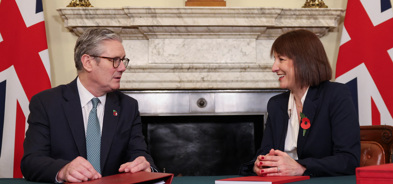The Autumn Statement – what’s in store?
Ahead of the Autumn Statement on 17 November, Jason Hollands looks at what’s in store and reminds us of the importance of using available tax allowances where possible.
The value of investments can fall as well as rise and that you may not get back the amount you originally invested.
Nothing in these briefings is intended to constitute advice or a recommendation and you should not take any investment decision based on their content.
Any opinions expressed may change or have already changed.
Written by Jason Hollands
Published on 10 Nov 20228 minute read

Next week’s Autumn Statement looks set to herald both spending cuts and tax rises, adding to the painful squeeze facing businesses and households as the economy slips into recession. Falling real earnings, rising borrowing costs and higher taxes are a toxic trio for many people’s finances.
Unsurprisingly, speculation is rife as to which taxes might rise, aided by briefings from various ‘sources’ in Westminster. This kind of kite flying of potential measures has become increasingly common in UK politics and is used to test the likely extent of any backlash.
Millions more set to be sucked into higher rate tax bands by stealth
Even without new measures, the continued freezing of personal tax allowances set in motion by Rishi Sunak when he was Chancellor, is having a very painful effect that will worsen further. The number of people being drawn into the net of higher rate taxes is already estimated to have surged by 43.9% since the 2019/20 tax year to 5.5 million this year [1].
Given growth in total pay – including bonuses – had risen to 6% in June to August [2] as employers have been confronted with rising inflation and wage demands, the number of people drifting into both paying income tax for the first time and above the higher rate threshold of £50,271 is certain to surge considerably higher.
With the allowances already due to be frozen to April 2026 – and potentially extended further in next week’s Autumn Statement – millions more people are going to end up as higher rate taxpayers over the coming years. The number of people paying higher rate tax is estimated to have grown by 15% this tax year [1], so it’s not inconceivable that the number of people paying it could exceed 8 million under a prolonged freezing of allowances.
What can be done about this? The main route to mitigate exposure to higher rate income tax is through making pension contributions, as these currently provide tax relief at your marginal rate. Those who have the option of contributing via salary sacrifice should certainly consider it as this system offers relief from national insurance in addition to income tax.
Pension tax relief – will luck run out for the ‘cat with nine lives’?
You can see how tempting it might be for the Government to finally bite the bullet and limit pensions tax relief to the basic rate or a new flat rate to block this escape route. Alternatively, the Government might choose a simpler route of reducing the annual pensions allowance down from the current gross amount of £40k per annum.
The gross value of tax and national insurance relief on pensions is approximately £44 billion annually and has risen significantly since the introduction of auto-enrolment into workplace pensions in 2012, which has seen private sector workplace pension participation more than double. Yet 58% of this pensions tax relief is accounted for by higher and additional rate taxpayers. A move against pensions tax relief – or the annual contribution limit – would certainly raise significant taxes but reduce the attractions of pension saving for millions of Britons in the process.
There would be some political cover as the opposition parties have previously called for a similar overhaul, making it hard for them to oppose such a measure. However, it would carry considerable political risk among core Tory voters and meddling with pension allowances could also reignite problems with senior medical professionals who enjoy generous NHS pensions.
Mitigating any rise in capital gains tax
Another area slated for tax hikes, or a reduction in the annual tax-free exemption, is capital gains tax (CGT). Some had expected Rishi Sunak to launch a CGT raid in Spring 2021 having ordered a review into the tax, but it didn’t transpire in that Budget.
Higher rate taxpayers can currently crystallise gains of up £12,300 per annum tax-free with anything over this subject to CGT at 20% for most assets and 28% for property that is not their main home. Raising CGT would be a particularly hard blow for business owners looking for an exit, as well as investors with assets outside of ISAs and pensions.
If we do see a tougher CGT regime announced next week, it will certainly reinforce the case for using ISAs and pensions where possible, as gains within these are not taxable. But there are other steps that could be potentially taken to reduce or eliminate exposure to CGT. Married couples and those civil partnerships can transfer assets to each other – known as an interspousal transfer – to make use of both sets of allowances, as well as shift a potential gain to whichever partner might be exposed to a lower tax band.
Dividend tax raid?
Another area it has been suggested could be targeted are dividends. In recent years, the annual tax-free dividend allowance has been slashed from £5,000 in the 2017/18 tax year to just £2,000 currently. A 1.25% increase in dividend tax rates, announced by Rishi Sunak as Chancellor, which Liz Truss had vowed to scrap, is being reinstated. Any further moves to raise taxes on dividends will be a blow to business owners, many of whom pay themselves partially or primarily through dividends rather than salaries, as well as retirees who rely on dividend income to supplement their pensions.
It’s yet another reminder to consider ISAs, as far as possible as a tax-free umbrella for owning investments. Shares or funds held in a taxable environment can be sold and repurchased within ISAs – a process known as Bed and ISA – to ensure that future dividends are free from the grasp of HMRC. However, people should take care not to incur a CGT hit during the process.
Inheritance tax
The nil rate band for inheritance tax (IHT), has been fossilised at £325k per person since 2009 and, like other personal tax allowances, is already being frozen until at least 2026, a period which the Chancellor may decide to extend. Had it been adjusted for CPI inflation since 2009, it would be approaching £470k based on the most recent inflation data.
Unsurprisingly, ever more people who would never have imagined being hit with death duties are finding that their parents’ or grandparents’ estates are becoming subject to these taxes, especially given the strong rise in property and share prices over recent decades.
Extending the current freeze on IHT thresholds would amount to a significant wealth tax over a period that should see a bonanza of inheritances as deaths from the post-war baby-boomer generation rise. The average life expectancy in the UK in 2018-2020 was 82.9 for women and 79.0 for men [3], so extending the freeze by two years would have a major impact.
While there are multiple ways to mitigate a potential IHT liability, including making lifetime gifts which become potentially exempt after seven years, this does require careful planning well ahead.
Make use of your allowances
Irrespective of which specific tax rises are announced next week, it is very clear that the tax burden is going to remain high for the next few years. More than ever, it is wise to make as much use of the annual allowance available while you can to try and protect your wealth and ensure as much of your savings interest and investment income are tax-free.
On a final note… the state pension triple lock
When assuming the office of PM, Rishi Sunak said he was committed to the 2019 manifesto. Alongside pledges not to raise income tax, national insurance and VAT, that manifesto also committed the party to the State pension ‘triple lock’ – a mechanism that guarantees the state pension will rise by the highest of average wages, consumer inflation or 2.5%. This means the state pension is set to rise by 10.1% from next April, at a cost of about £10 billion to the Exchequer – which illustrates the steep budgetary cost of maintaining this pledge.
It is far from sacrosanct, however, having already been suspended last year, when anomalous pay increases caused by the UK emerging from Covid lockdowns meant that pensioners received a 3.1% raise – well below the 8.3% increase in average wages [4]. Apart from the fiscal burden, the lock is seen as inter-generationally unfair in some quarters; while opposing views point to the comparatively stingy level of state-funded retirement income in the UK compared to peer nations.
It seems unlikely that the Tories, lagging Labour by a huge gap in the polls, will target a measure that would leave them facing accusations of betrayal from core voters. However, a hard-pressed Chancellor could argue the 10.1% inflation in September is also an anomaly, and water down the lock again for a year while pledging to reinstate it the following year, before an election.
If the lock is retained, then the full state pension for those retiring after April 2016 will rise to £203.85 per week or £10,600 per year – taking it above the £10,000 benchmark for the first time.
Questions about tax allowances or your investments and financial plans?
Our Coaches are here to help. They offer free 45-minute sessions to give you the opportunity to talk through your finances with a qualified professional. Find out more and book a session.
Important information
The value of an investment may go down as well as up, and you may get back less than you originally invested.
This article does not constitute personal advice. If you are in doubt as to the suitability of an investment please contact a financial adviser.
Prevailing tax rates and reliefs depend on your individual circumstances and are subject to change. ISA rules may change
Sources:
[1] National Statistics, Summary Statistics, GOV.UK
[2] Average weekly earnings in Great Britain, Office for National Statistics
[3] Office for National Statistics, September 2021
[4] Department for Work and Pensions, GOV.UK
Get insights and events via email
Receive the latest updates straight to your inbox.
You may also like…


Market news
2024 Autumn Budget Overview: The key announcements from Chancellor Rachel Reeves




